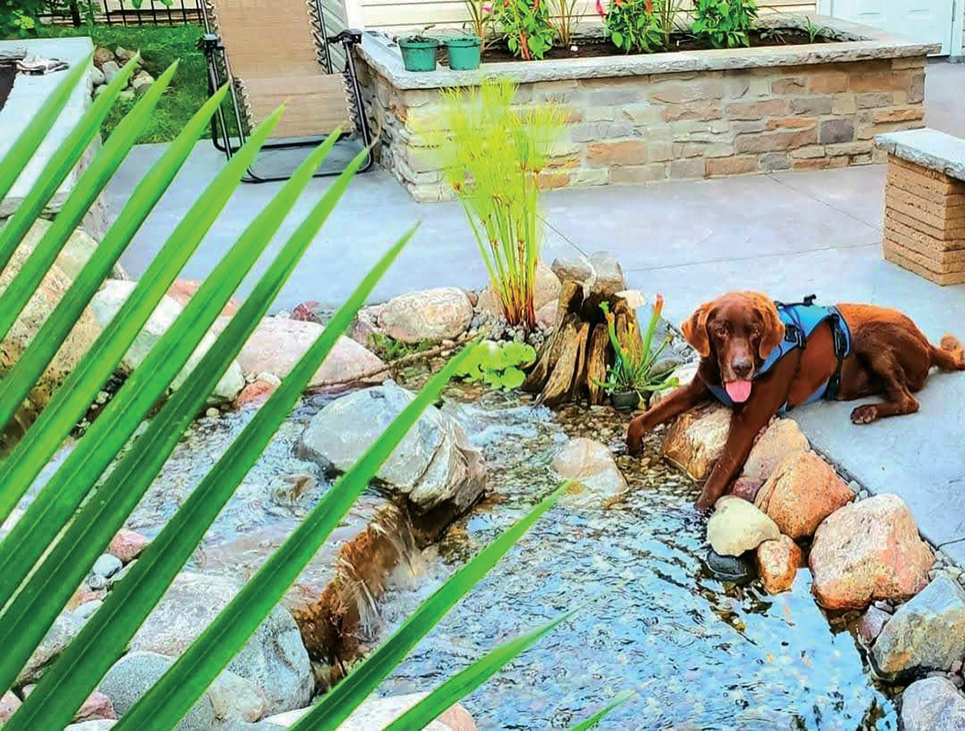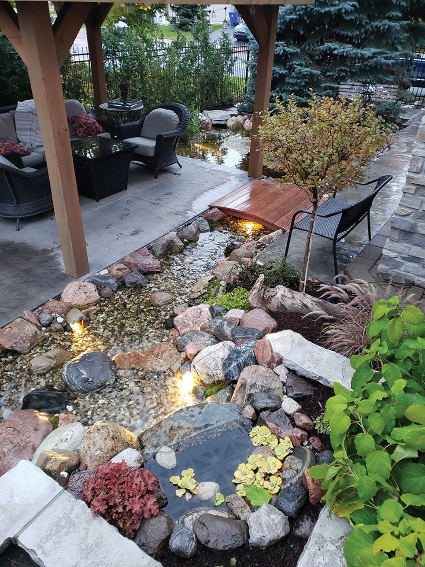
When we were approached about this natural pond construction project in Aylmer, Quebec, Canada, the client had already done lots of research. He found Geert’s Land & Waterscapes through a Google search. The job site was only 1 ½ miles from our home base. He was planning to do the backyard pond project himself, but he realized that it would have been too intense and time consuming.
Building Outside the Box

He provided me with a colored computer-generated design of the idea he wanted. After I saw the design layout of this rather small backyard, I knew this would be another “outside-the-box” and unusual project, but with a very beautiful end result.
The design was very formal with a square-pond layout. The clients had Alamode Concrete, a family member’s operation, install all the stamped concrete pathways, including two pads for a round and square cedar gazebo. We helped the stamped-concrete contractor design the two bridge cutouts for the curved bridge placement and the above-ground concrete planter boxes, specifically the U-shaped wall area.
This is where we would place the biofilter box. We needed to make sure the large biofilter fitted properly due to space constraints around the new concrete planter boxes. The biofilter box berm and the start of the stream also needed to look as natural as possible around the 90-degree turn of the pathway and avoid the “volcano look.”
For extra filtration, we made a mini bog-filter area to the right of the biofilter box at the start of the stream. This slowed down the water coming in and out of this area. Near the end, we added a small tree stump and planted some seasonal water lettuce, a pitcher plant and a ‘Little Giant’ papyrus. The plants did very well there in just three months.
Follow the Leda

The native backyard soil was hard and heavy Leda clay, something the Ottawa area is known for. So, the hand-shovel carving of the pond shelves proved a bit time consuming. We wanted to make the pond and stream look as natural looking as possible, which the client approved.
The pond is approximately 14 by 17 feet, with the deepest shelf 30 inches. We added a fish cave at the bottom, as blue herons frequent the nearby Ottawa River. We designed the pond so guests can dangle their feet into the water while sitting on the gazebo floor.
The stream is approximately 27 feet long and posed the biggest challenge. We had to figure out how to best attach and disguise the EPDM liner. Because the stamped concrete walkways were only 4 to 5 inches thick, we didn’t have much stream depth to work with. We then carved out the center of the streambed a bit to get a better-looking stream.

The 2-inch diameter PVC flex pipe connecting the skimmer pump to the biofilter box also posed a bit of a challenge, due to its installation between two concrete paths. We installed a PVC pipe inside the streambed area beside the path edge in a sand bed and covered it with the underlayment and liner.
We used the Atlantic PS 4600 skimmer and their BF 2600 Filter Falls biofilter box. For the pump, we used the OASE Waterfall Pump 5150 GPH synchronous magnetic pump with a grounding plate. The skimmer box has a 2-inch PVC flex overflow pipe to a drainage pit, as rainwater runoff will be an issue here thanks to the gazebo roof and non-permeable pathways. We added an Atlantic faux-rock fiberglass lid to camouflage the black PVC skimmer lid.
Rock & Boulder Challenges
When we were sourcing the roundish granite pond and stream boulders, we had a bit of a tough time finding the 8-to-12-to-18-inch diameter size in my area of Aylmer, Quebec, north of Ottawa (the Nation’s Capital) and the Ottawa River. We deal mostly with local sand pits in my 20-to-25-mile-area radius, because of their price point and huge variation of color and character.
But as a result of the huge demand during the recent pandemic, several pit owners told us they have depleted their supply of rocks larger than 12-inches in diameter. We all, as great pond builders, know that larger rock looks way more natural in ponds and streams. We managed to find just enough properly sized boulders on this build to make it look as natural as possible.
For our future builds, especially the larger ones, we’re going to start using blasted angular Canadian Shield granite rock that often comes from major highway projects in the hilly areas of the Outaouais, Quebec region.
Final Touches
To attach the EPDM liner to the 12-by-12 foot gazebo floor and along the stream edges, we used ⅛-by-1-inch-wide aluminum flat bars. We installed the bars with 1.25-inch tapcon screws every 8 inches or so. We also used Geocel 4500 roof bonding sealant behind the liner before attaching the aluminum flat bars to the concrete. This way, we avoided water runoff from the concrete pathways entering behind the liner.

The client had a 3-by-4-foot curved cedar bridge built to go over the stream. We decided to bring all the pond and stream lighting quick-connect cables and splitters under the bridge. The main feed cable from the lights transformer arrives here. It was the most convenient and logical spot to disguise them. It will also be easy to troubleshoot in the future by quickly lifting the bridge.
For LED lighting, we used two 4-watt lights inside the pond, and two 2-watt stream lights near the biofilter waterfall area. For the under-bridge lights, we used two 1.5-watt Brilliance Mini Beam brass lights with completely hidden mountings. We find these mini bridge lights to provide a very nice effect in the evening. After the pond completion, we installed a small brown flagstone patio for guests to sit on — and perhaps feed the goldfish!
Enjoyment for All
This one-story home on a street-corner lot has a walk-out basement onto an older, covered dining patio. Above it is a three-season sun room for the full viewing pleasure of this new backyard water garden.

The clients are truly enjoying their retirement paradise. Many sitting and viewing areas were created, as they plan on entertaining quite a bit.
Another big fan of this project was Hunter, the 14-year-old chocolate Labrador family dog. This very aged dog with mobility problems enjoyed being in the pond or sitting at the stream edge, dangling his paws in the water . When he managed to get completely in the pond, he always had to be pulled out by his owners. He was not able to get out by himself. Sadly, Hunter passed away at the end of the summer. It pleased me to know that we gave him quite a bit of happiness in his final year.
We plan on featuring this pond on the 2024 Ottawa Pond Tour organized by the Greater Ottawa Water Garden Horticulture Society (GOWGHS) which I am involved with. Come experience it for yourself!


